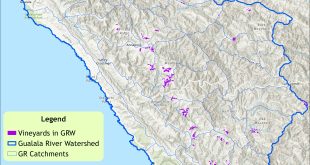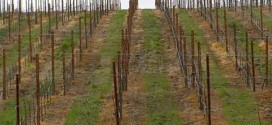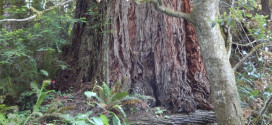| A version of this article was published in the Independent Coast Observer on July 25, 2003. |
The CAC accepted some changes to the language for timber conversions and sent it back to county counsel for more work. They approved a no-change timber harvesting recommendation which will go on to the planning commission.
Conversion changes
After the close of public comment at the June 19 CAC meeting committee members asked for changes to the timber conversion option three, which was strongly supported by the environmental community and opposed by many landowners.
Last week, staff brought in a new version of option three. Currently, timberlands, which are defined as capable of growing redwood or Douglas fir, are sought for conversion to vineyards.
Planner Dave Schiltgen explained the new option three language. The main addition is in the Resources and Rural Development Land Use Category: “Any uses that would require approval of a timberland conversion permit or would result in the effective loss of timberlands are not allowed unless they qualify for a timber conversion exemption pursuant to the Forest Practice Rules, they provide an overriding public benefit or they result in no net loss of timberland.”
The standard example planners give of an overriding public benefit is the Sea Ranch reservoir, built on a forested ridge.
Committee Member Dan Fein suggested adding language allowing no fragmentation of habitat. Planner Bob Gaiser said staff could go to county counsel and bring back language to reflect that they don’t want a timber conversion to create habitat fragmentation. The straw vote was 8 yes, 1 no, 1 abstention.
There was no public comment on the new conversion language, but environmentalists interviewed later ranged from being very pleased to regarding the changes as “a poison pill” that would allow environmental damage while placing unreasonable restrictions on landowners.
Setbacks from homes
Next, Schiltgen explained four options for the timber harvesting element. State law regulates timber harvest, but there is some case law allowing counties to apply restrictions and setbacks of residences from timber operations outside of Timber Production Zoning, he said.
Option one would not change the existing 1989 general plan language. Options two and three would allow setbacks from timber operations, without setting the breadth of the setbacks, and option four would prohibit timber harvest altogether outside Resource and Agricultural zonings.
Staff recommended option one: no change. Schiltgen said that timber harvesting does not cause enough trouble with residents to warrant setbacks. San Mateo County has a 1,000-foot setback that held up in court, but staff felt that was not reasonable for a private interest.
Fein asked what recourse citizens have when faced with timber harvest right next door to them. Schiltgen said that the California Department of Forestry’s process is the functional equivalent of an Environmental Impact Report under the California Environmental Quality Act. Gaiser said that options two or three would give neighbors recourse with the county.
The first speaker during public comment was Rick Coates of Cazadero, who represented Forests Unlimited. He said they supported option two allowing the most setbacks, combined with a 1,000-foot setback from homes. In the San Mateo case, he went on, setbacks from structures were based on the county’s police powers to protect public safety and health.
In Sonoma County during a logging operation on Bohemian Highway a tree was cut and missed a neighbor’s home by three inches and a power pole, which would have hit the house if it fell, by three inches on the other side.
Coates said it could have started a fire if it hit the power pole, and would have damaged the house if it had fallen a few inches either way. Petaluma Rancher Al Gerhardt spoke for no change and cited fire danger from timberlands.
Timber weighs in
Henry Alden, chief forester for Gualala Redwoods Inc. said the company owns 20,000 acres in Sonoma County. GRI owner J. Ollie Edmunds was also present but did not speak publicly.
Alden said that current state rules are working. GRI negotiations with The Sea Ranch led to an agreed 200-foot setback of logging from residences. “I strongly urge you not to go into timber regulation,” he said, and supported no change.
Joni Goshorn of Gualala and Santa Rosa said that her experience with the CDF process was that officials seemed to disregard public input. She said the county could provide a better venue for public comment on timber operations.
John Williams of Santa Rosa, who was Alden’s predecessor at GRI, and now runs an environmental consulting firm, asked for no change. He said the problem is an urban / rural conflict, and that driving timber out of the county is economic imperialism. California has the strongest and most protective timber regulations in the country, and perhaps in the world, he said.
The problem is an incursion of residences into timberlands, Williams went on. He would like to see a right-to-harvest-timber ordinance similar to the right-to-farm ordinance. Timber harvesting maintains habitat while reducing fire danger, he said.
Williams’s colleague, forester Bonnie Burchill, said that the CDF process has worked well in Sonoma County and she supported no change. She said the forest she grew up in near San Diego died through mismanagement. Landowners need an incentive to manage the resource, not regulations perceived as punitive. She added that the CDF permit process is a CEQA document and does involve the public.
Fein asked how she would respond to Goshorn, who said that CDF is not responsive. Burchill said that the Timber Harvest Plan is a robust document that mitigates environmental impacts to insignificance, includes review by the Department of Fish and Game, Water Quality, and the Division of Mines and Geology. Adjacent landowners are notified. It becomes a public document. The process includes a public Second Review hearing held in Santa Rosa.
Matt Green, a local forester and firefighter, showed them a THP an inch and a half thick. He said neighbors now can ask for certain trees to be taken or left, but that would not be possible with a no-cut buffer.
No change
A motion was made and seconded to recommend no change.
Committee Member Bob Marshall of Sea Ranch said that Gualala Redwoods Inc. is a fairly good corporate citizen. He has been in negotiations with them.
“Every THP that was in negotiations between GRI and TSR only got better in terms of public benefit,” he said.
Over the ridge, Marshall went on, when there was no discussion, logging operations “looked like somebody had dropped a bomb,” and the streams were polluted for years afterward.
“The more forum, the more discussion, the better off we all are. It would really help matters if we could create another forum.” Marshall said he would not support the motion. It passed 5 – 4.
 Friends of Gualala River Protecting the Gualala River watershed and the species living within it
Friends of Gualala River Protecting the Gualala River watershed and the species living within it


